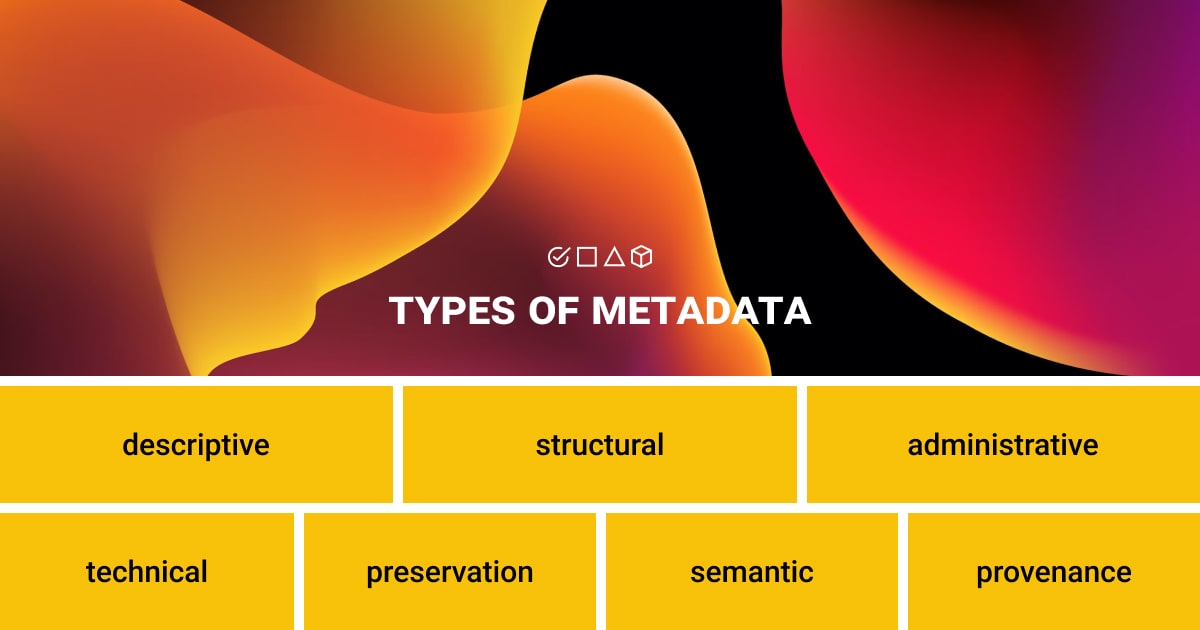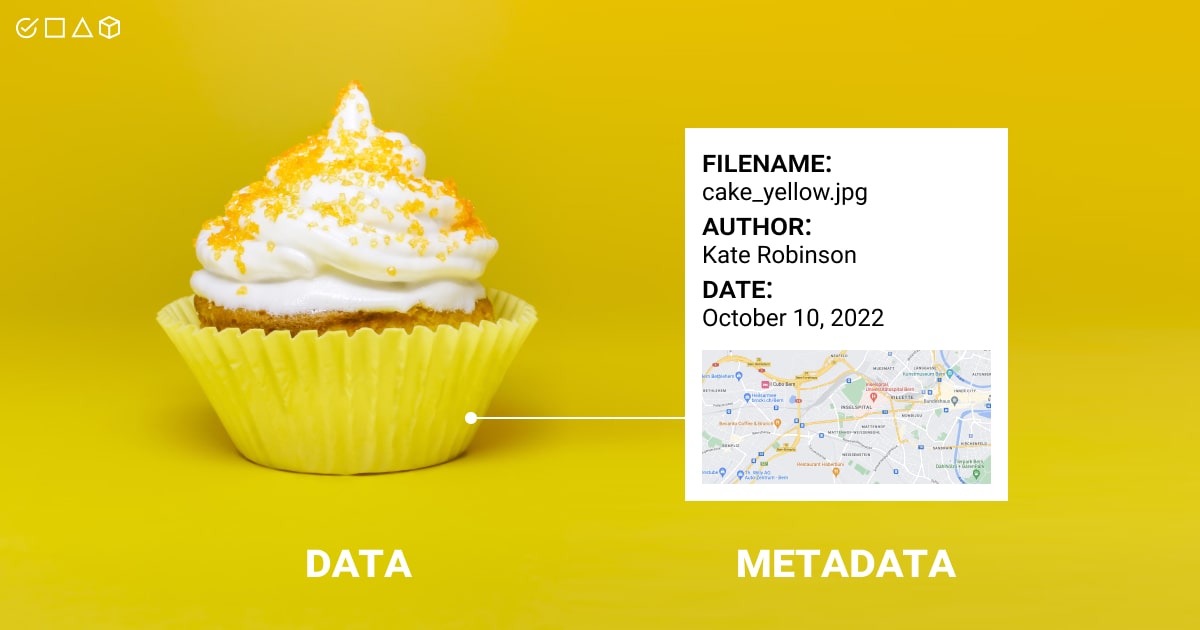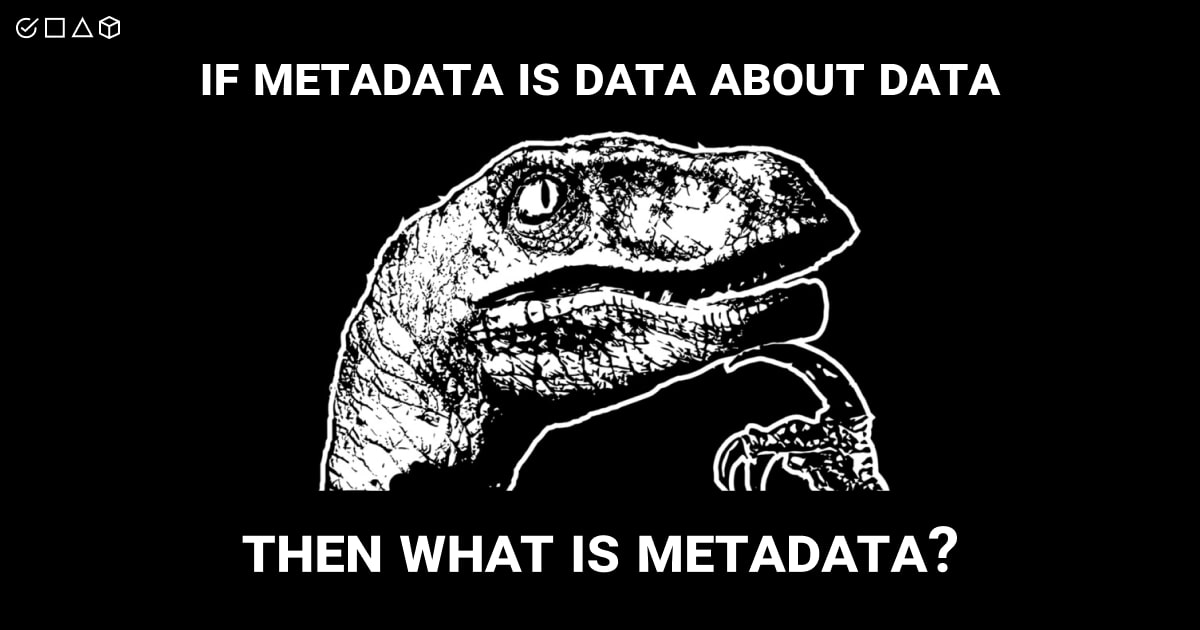What Is Metadata, and Where Does It Go?

If you work with data for a machine learning project, you’ve definitely come across a term such as metadata. A simple metadata definition would be “data about data.” This means any information about the data that makes it more structured, encoded, and clear for the machines to comprehend it. As a result, metadata enables better identification, retrieval, evaluation, and administration of the necessary data.
In his book, called Zen and the Art of Metadata, John W. Warren refers to this concept as “both a universe and DNA” and “the key to discovery.” So, what’s all the fuss about metadata?
Even though metadata describes the specific data, it’s not the data itself. Metadata makes it simpler to discover, use, and reuse specific instances of data as it condenses fundamental information about that data. Basic document file metadata includes things like author, creation and modification dates, and file size. As a result, you can easily find a certain document or file when having the option to search for a specific aspect(s) of metadata.
The sole function of metadata is to define and explain the connected data item. Let’s say you have a web page. It could contain metadata that provides information on the tools used to build the page, the objects it portrays, the software language it was developed in, and so on.
Let’s learn more about this topic by going through a few examples and use cases of metadata in the real-world and the digital landscape, before delving further into the significance of metadata and proper metadata management.
A Closer Look at Metadata: Why Does It Matter for Your Data?

Metadata is everywhere. You come across metadata every time you open an email, use your smartphone to snap a picture, read a book, or make a purchase online. Metadata is the dietary information printed on the packaging of food when you do grocery shopping. The information about the goods themselves, including the product picture, size, color, brand, and price tag, is also metadata.
In this article, however, we’ll focus more on digital metadata and its applications. In computer science, the term “metadata” is overused and subject to many interpretations depending on the situation. Metadata, however, was generally understood to be a formal representation of data that specifies and characterizes information in a consistent and stable manner.
What is metadata used for? Metadata is often used for computer files, images and videos, audio files, web pages, spreadsheets, and relational databases. On a web page, for instance, metadata (represented by meta tags) includes keyword-related descriptions of the page’s contents. The accuracy and specifics of this metadata might have an impact on a user’s decision to visit a website because search engines frequently display it in search results.
Both manual and automatic information processing methods can produce metadata. The manual approach is usually more precise, since it gives the user the freedom to include any details they deem pertinent or useful for describing the file. Automated metadata generation can be simpler, however, typically merely presenting details like file size, file extension, creation date, and file creator.
Metadata & Data Quality
Data users occasionally fail to consider the impact of metadata. They consider it to be little more than labels, with no added value. However, they can’t be more wrong because metadata directly relates to data quality, a fundamental aspect of data.
Data quality becomes more crucial the more information you want to extract from it. This also turns into a bottleneck in the age of Big Data. When working on a project in AI, we want the impact of inaccurate data to be as little as possible, right? For this reason, we use anomaly detection and automated warning systems. Without data understanding, or more specifically, without metadata, we wouldn’t be able to achieve high-quality and reliable data.
The Key Types of Metadata

Metadata is used to describe other data. It’s made up of properties, which describe the entities in each ML dataset, and their values. Files, cases, samples, and cell lines are all examples of entities, which are specific resources having UUIDs. The entity’s properties can either explain it or connect it to other entities. The vital condition, gender, data format, or experimental approach are a few examples of such properties of an entity.
Furthermore, metadata comes in different types, depending on the type of information it provides about the data:
- Descriptive metadata
As the name suggests, this type of metadata describes particular information about a file or a resource and is responsible for finding, recognizing, and choosing them. Title, author, abstracts, keywords, and themes are examples of components that descriptive metadata could contain. Also, it could include the file’s name, location, and size.
- Structural metadata
Metadata that tells about the structure of the data is referred to as structural metadata. It informs users about a resource’s or file’s organizational structure. A table of contents is an illustration of this type of metadata, which is typically employed in machine processing. It shows which pages from which chapters are connected to one another.
- Administrative metadata
Technical data that assists in resource management is known as administrative metadata. This might be the file’s creation date, type, permissions, etc. Administrative metadata is closely connected to usage rights and intellectual property. As such, resource management is made easier with administrative metadata.
- Technical metadata
One of the categories of metadata is technical metadata, which gives computer systems the details they want about the format and organization of the data. Physical database tables, access restrictions, data models, backup policies, mapping documentation, data lineage, etc. are some examples of this type of metadata.
- Preservation metadata
Preservation metadata is used to support and record the preservation process for digital files. By offering contextual information, use details, and rights, this metadata helps to preserve a digital object’s usability while assuring ongoing access.
- Semantic metadata
Semantic is about the meaning, and, in this case, about the meaning of data. Semantic metadata provides references to ideas that are explicitly represented in a knowledge graph, assisting computers in deciphering the meaning of the data. It creates new methods for classifying, finding, and utilizing data (in an automated or semi-automated approach), making the process simpler and more affordable.
- Provenance metadata
Data assets’ origin may be determined by looking at their provenance metadata. It provides information about data sources, ownership, transformations, freshness, usage, and archival.
Metadata Management: How to Make Use of Metadata?

Complex statistical representations we might get from a single dataset may be too much for some individuals to handle. Others could as well dismiss the extra knowledge, thinking of it as worthless. Although we don’t always need to build a histogram every time we interact with data, it does save the day.
When you work with metadata, some golden rules can tell you how to get the most out of metadata:
- Focus: While some data needs to be strictly stable, other data needs to be examined to see whether it is righteous and of the highest quality. The information gathered as metadata needs to be modified for each type of data. Distributions based on statistics, historical patterns, inconsistencies… All of them are referred to as the metadata strategy. While working with both data and metadata, we are constrained by space and manpower, so it’s important to carefully consider where to focus.
- Numbers: The actions that follow the metadata strategy include data quality measurement. We could decide to evaluate the entire database, a few tables, a particular set of columns, the total number of values, the string’s maximum and minimum lengths, and the percentage of missing data. Using this data to generate results will determine what we need to measure.
- Time: Data changes and those transitions are being monitored when insights are extracted using metadata. And how much detail is required to address data quality will determine when to track metadata. We then adjust our measurement to the rate of change in data.
Metadata Tools for Best Management Practices
Making data searchable, accessible, and understandable requires effective and automated metadata management. To make this possible, we need specialized tooling for managing metadata to add important information to the data that is stored in a business context.
A metadata tool is a program with different functions and a wide range of usability to enable metadata automation. Among its key features are data catalog, compatibility with multiple connectors, business glossary, data lineage, data profiling, impact analysis, and metadata ingestion and translation.
Here’s the list of the top metadata management tools to assist you in finding the finest tool for your business:
- IBM InfoSphere Information Server
- Alation Data Catalog
- Alex Data Marketplace
- Informatica Metadata Manage
- Oracle Enterprise Metadata Management
- ASG Enterprise Data Intelligence
- Collibra Platform
- erwin EDGE Portfolio
- Infogix Data360 Govern
Data Annotation with Metadata

Since metadata meaning is data about data, and it is something that makes data more clear and understandable for machines, this instantly recalls the process of data annotation. How are the two connected? Data labeling is a crucial part of the entire data processing pipeline in machine learning, wherein target data points are annotated with metadata for various ML tasks. The metadata, in this case, is presented in the form of tags (aka labels) that are added to all kinds of data, including images, videos, texts, or audio. Hence, it’s fair to say that data labeling is the process of adding metadata to collected data (raw and unstructured). This way, we receive valuable attributes of an existing dataset.
We add relevant metadata to a dataset in order to help machine learning algorithms comprehend and learn from the data it has been given. Case in point, image annotation is fundamental to enabling many applications of computer vision technologies, face recognition systems, and other AI solutions that rely on ML to recognize patterns in the image data. These images must have metadata added to them, such as identifiers, captions, or keywords, to train these solutions.
To teach machines how to correctly perceive and comprehend human emotions through words, we use text annotation. In essence, it’s the process of applying metadata tags to emphasize words, phrases, or sentences. To give text more depth and significance, we use semantic annotation and add metadata to documents that will enhance the content with concepts and descriptive phrases.
With that said, creating a training dataset for machine learning requires adding thorough and consistent metadata. Data labeling provides more detailed meta-information about the variable for an ML model.
On a Final Note

Finding the best method to handle and organize data is equally vital today as both data importance and business performance increase. For better organizational efficiency, proper metadata management is crucial for consistent metadata definitions, administration, and preservation of data across the company.
However, while it might be expensive and difficult to create relevant metadata, it can be a powerful tool for classifying, characterizing, and processing necessary information. By fostering a common understanding of data and its context within a firm, there’s a potential to enhance metadata creation and classification for various business purposes.
At Label Your Data, we think metadata is just as important as the data itself. The people who understand their data are the ones who own it and, thus, can capitalize on it.
Do you need to add relevant metadata to your data to get the project started? Contact our team of annotation pros for more information!
Written by
Karyna is the CEO of Label Your Data, a company specializing in data labeling solutions for machine learning projects. With a strong background in machine learning, she frequently collaborates with editors to share her expertise through articles, whitepapers, and presentations.

